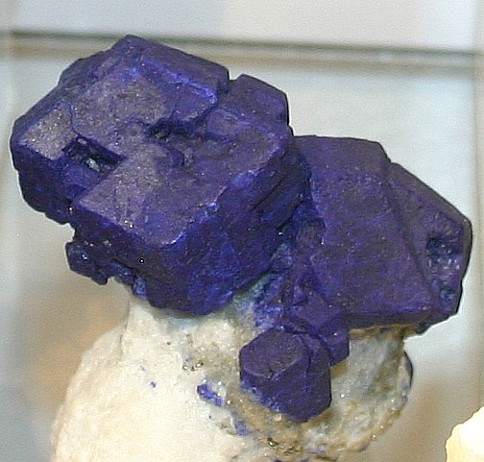|
.
Lazurite Mineral Facts:
Formula: (Na,Ca)8(Al6Si6O24)(S,SO4,Cl2)
It is normally found with small amounts of
sodalite and hauynite molecules in isomorphous replacement.
Colors: Deep
azure-blue, greenish blue.
Its streak is blue.
Hardness:
5.0 to 5.5
Density: 2.4
to 2.45
Cleavage:
Dodecahedral.
Crystallography: Isometricic
Crystals are rare, but when found are usually dodecahedral. The material
is commonly massive and compact.
Luster:.
Vitreous, translucent to opaque.
Optics:
(Refractive Index) = 1.502 -
1.522
|
 |
|
.
Composition,
Structure and Associated Minerals:
A rare mineral, occurring usually in crystalline limestones as a product
of contact metamorphism, also in syenites, etc.
The Persian word for blue is the origin of it's name.
Lazulite is the
mineral coloring agent in the beautiful blue gem Lapis lazuli, which usually
consists of a mixture of massive lazurite with small amounts of
calcite,
pyroxene, etc. It commonly also contains small disseminated particles of
pyrite.
It is used as an ornamental stone, for carvings, etc.
Lapis lazuli is used as an
ornamental stone in the manufacture
of vases, and various ornaments, in the manufacture of mosaics, and has long
been used as a pigment, when ground top a powder, under the name
ultramarine. Most of the ultramarine at present in use, however, is
artificially prepared by heating together clay, sodium carbonate, and
sulphur. Because the artificially made pigment costs only about one-fiftieth
the price of the powdered natural mineral, the latter practice of crushing
lapis lazuli has been almost entirely superseded. |
 |
|
|
Identification and Diagnostics
Lazulite is fusible at 3.5, giving strong yellow flame (test for
sodium), and fusing to a white glass. Its powder bleaches rapidly in
hydrochloric acid, decomposing with the production of gelatinous silica
and bubbles of H2S. It is distinguished from blue sodalite and hauynite
by the reaction with HCl, especially by the evolution of H2S.
Occurrence,
Localities and Origins:
As lapis lazuli, this
material is much used in jewelry, and has been used by man for many
thousands of years. The ancient Egyptians fashioned amulets carved in this
material, and they are common enough that many have been found.
The
best quality of lapis-lazuli comes from the
Badakhshan Province
of northeastern Afghanistan where it has been mined for thousands of years.
Also found at Lake Baikal, Siberia, Greenland, Baffin Island, Canada,
in the limestone inclusions in the lavas of Vesuvius, in the Albanian
mountains
of Italy and in the Andes of Ovalle, in Chile.
In the US it has been mined on Italian Mountain in Colorado and near Mt
Baldy in the San Gabrial mountains of San Bernardino County, California.
Return to the
Mineral Collectors Information Page |


